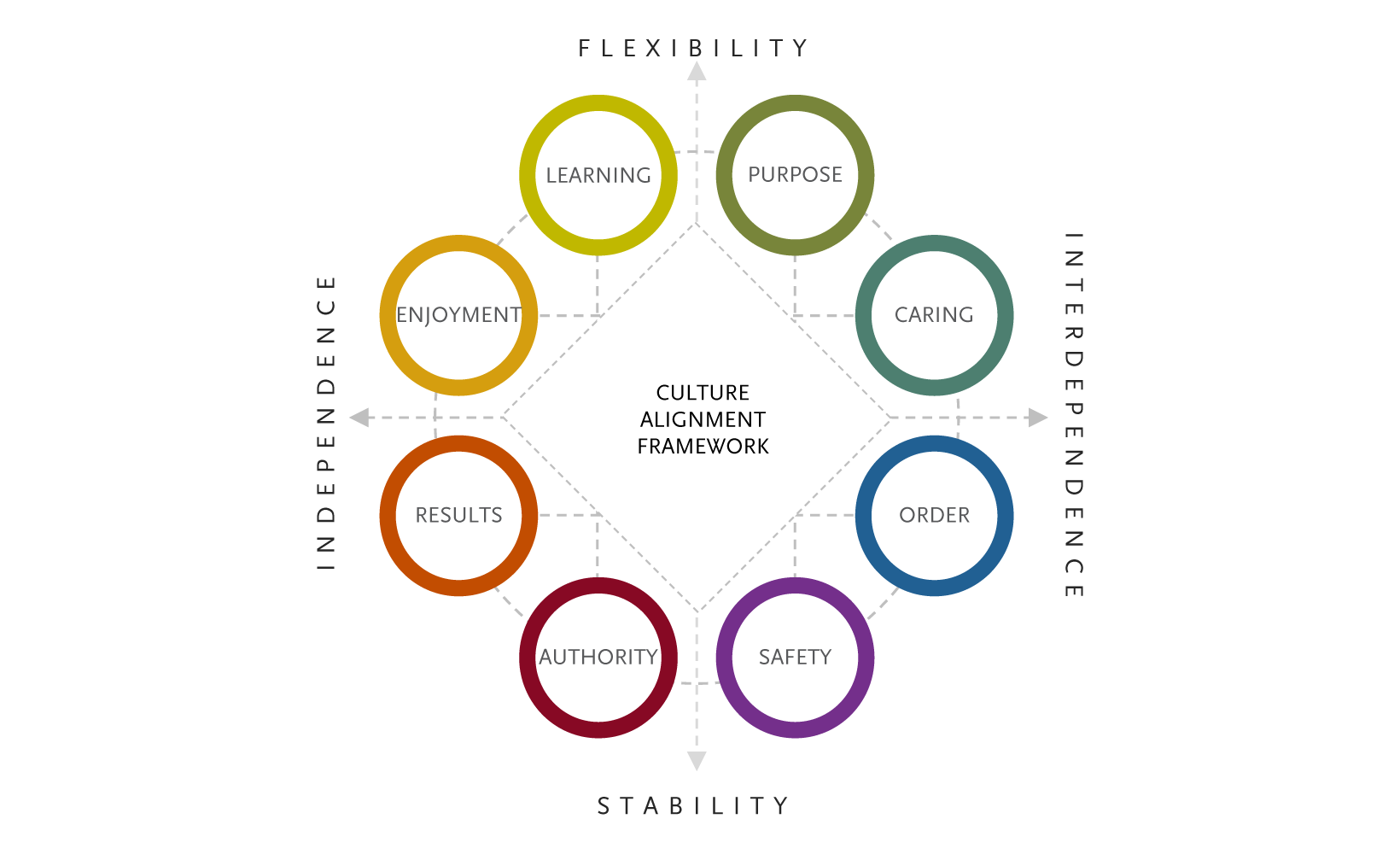An ever-growing body of research points to the positive
impact the right organization culture can have in
enabling positive financial, employee and customerrelated
outcomes, while recognition of the destructive
impact of cultural dysfunction is growing. As a result,
the topic of culture has attracted more interest
among business and HR leaders than ever before.
Leaders and leadership teams are now even being
measured and held accountable for their impact on
organizational culture, arguably as they should be.
At Spencer Stuart, culture underpins many of the
discussions we have with leaders — not only when we are
brought on as consulting partners for targeted culturerelated
interventions, but also in broader conversations
about executive search, assessment, development and
succession, all of which are inextricably linked with
the organization’s current and aspirational culture.
We looked closely at the nature of these discussions in Asia, and found a few common
themes around the thinking of business and HR leaders on the topic of culture:
The penny has dropped. Few leaders today need convincing about the importance
of having the right culture in achieving organizational strategies. With the why
settled, we have moved on to talk about the what and the how.
The language for talking about culture remains elusive. Lack of commonly understood,
shared vocabulary and frameworks to describe culture often leads to
ambiguity and inconsistency in the way it is understood and explained.
Different people, different perceptions. When asked to identify the most dominant
dimensions of the culture in their organizations, it is surprising how frequently
even highly tenured members of the same leadership team present misaligned or
divergent views.
Striving for the ‘ideal culture.’ Most leaders today display an intellectual appreciation
for the fact that organizations can succeed with vastly different types of
culture. Yet, the subtle glorification of certain cultural dimensions is evident in
most such conversations. Infusing greater learning, innovation and agility into
their cultures — particularly inspired by organizations like Google — is a request
we frequently come across.
A fragmented, rather than integrated approach to culture. A large number of
companies today think about their culture in some context or the other, whether
that’s understanding the potential culture fit of new hires, focusing on cultural
integration in an M&A situation or aligning cultural strengths to the employer
value proposition (EVP). However, few organizations look at culture in a holistic
manner, taking into account all the ways in which it manifests itself, evolves and
changes over time.
In the last few years, Spencer Stuart has partnered with a number of organizations
across various industries in the Asia Pacific region, helping them assess, articulate,
build or transform their cultures. We looked back at these and identified five key
questions that organizations concerned about their culture must think about:

Are we thinking of culture as a magic wand?
The recent buzz in management literature around the topic of culture has led to a
situation in which culture is at once blamed for, and seen as solution to, almost
every organizational performance issue. Whilst the criticality of culture shouldn’t
be understated, it is important for organizations to also think through other factors
that may have the same or larger impact on the problems they are seeking to solve.
Spencer Stuart’s organizational health framework can provide useful guidance in
this regard. Six key inter-related factors — in addition to the external environment
— impact organizational health and performance. These include the firm’s leadership,
strategy, people, networks, systems and of course, culture. Organizational effectiveness and performance could be impacted by any of these, and without
looking at the organization holistically, culture-related interventions may be found
wanting in delivering the desired outcomes.

Do we really understand our current culture?
We have mentioned the not-uncommon lack of alignment among leadership teams
in the way individual leaders perceive and describe the culture of their organizations.
It should come as no surprise, therefore, that there often exist significant
differences in the ways cultures evolve and get manifested across different locations,
functions, etc., within the same organization. A clear appreciation of these
differences and the reasons contributing to organizational sub-cultures (like
history of the unit, impact of the leadership, etc.) is essential for gaining a nuanced
view of where things stand currently. It is equally important to distinguish between
the articulated and the actual, emergent culture, which can be very different. A
formal, structured assessment of the current culture, therefore, is a critical first
step in any culture-related intervention.

What is the impact that our culture is having?
In their desire to adopt elements of what they perceive to be the ‘ideal’ culture,
many organizations skip the important step of considering how the current culture
is affecting various organizational outcomes and, by extension, how changing the
culture would impact those outcomes. We use the Spencer Stuart Culture
Alignment Framework to help organizations understand the dominant cultural
dimensions at play, but also the employee, customer and business outcomes that
the culture correlates with.
Culture Alignment Framework

Indicators of Cultural Performance
- Satisfaction
- Culture liking
- Pride
- Advocacy
- Loyalty
- Motivation
- Unity
- Clarity
- Leadership
- Quality
- Customers

What should our culture be like?
There is no short answer to this, but we encourage organizations to consider the
following, when thinking about the culture styles they want to emphasize:
-
First and foremost, the culture must always be aligned to the strategic goals a
company is trying to drive. Imagine a regulatory or fraud-prevention body with a
culture emphasizing enjoyment and learning, over safety and order!
-
It is always easier to build on what you have, so leverage and reinforce the
strengths of your current culture instead of trying to change everything. Culture
has staying power; use yours to your advantage.
-
Always consider the trade-offs and unintended consequences of any change.
Our culture framework can provide some helpful initial guidance on potential
trade-offs and consequences. Broadly, the styles (depicted in the eight circles)
that are furthest away (diagonally opposite) from one another tend to emphasize
somewhat contradictory cultural behaviors. For example, Results emphasizes
an outcome-focus, while Caring emphasizes a relationship-focus. While it
is certainly possible to have such divergent elements co-exist as an organization’s
dominant culture, it requires a careful and deliberate balancing act.

What does cultural transformation entail?
Whilst it is not possible to cover all nuances of cultural transformation in this article,
we see the following as fundamentals that organizations embarking on this
journey must take into account:
-
Obtaining the buy-in and alignment of stakeholders early in the process — ideally at
the point of identifying change priorities. A process of open debate and discussion
to jointly agree on the way forward helps drive the engagement of the leadership
team and other stakeholders with the change agenda.
-
Synchronizing actions and activities around change. Standalone initiatives, no
matter how impactful, cannot drive sustainable culture change. Organizations
must think through the changes required in all aspects, to move the needle on
culture — the actions of their leaders, the stories that are told in/about the
organization, the systems and processes in place, and lastly the capabilities and
behaviors of employees.
-
Understanding the readiness of the leadership team for driving the change
agenda. Much research has shown that leaders have a disproportionate influence
on the culture of their organizations and teams. By extension, leaders
whose personal leadership styles and cultural preferences are closer to the
cultural dimensions an organization is trying to reinforce, and those who display
higher change agility, are likely to be early adopters of the change.
Structured assessments of the leadership team on these elements can help to
identify the change agents within the company, and highlight when there is a
need to bring in fresh blood and diverse perspectives and styles to complement
existing leadership styles.
-
Ongoing measurement of the progress. We know what is measured, gets done.
Contrary to the popular belief that culture is intangible and tough to measure,
we have seen that organizations that are serious about culture transformation
are very disciplined about putting in place specific goals and metrics, and regularly
taking stock of the progress against these. In identifying these objectives
and metrics, we encourage our clients to measure the outcomes, i.e., the actual
change in culture after a certain amount of time, and also the roadmap, by
having specific, measurable targets against the various actions identified for
driving the desired cultural changes.
In summary, while culture change is not a quick-fix for
any company, it also doesn’t need to be as elusive as it is
often made out. Through this article, we hope to provide
organizations and leaders with some insights that may be
valuable as they think through their culture change journey.
Partnering with an organization in the
semiconductor industry to drive culture change
With a change in leadership, a leading supplier of chemicals used in semiconductor
manufacturing saw a timely opportunity to proactively shape organizational culture, with
a view to aligning the culture more strongly to the future strategic objectives of
accelerated growth and performance.
A diagnostic of the company’s existing culture revealed a strong emphasis on results, preparedness
and process-focus. Taken together, these enabled the organization to deliver superior outcomes with
regard to quality and efficiency, but left some room for improvement when it came to agility, customer
intimacy, cross-functional collaboration and employee engagement. Recognizing the criticality of the
latter aspects for the business to deliver against the significant growth expectations, the leadership
team established focused goals for infusing more openness to change and greater collaboration, while
reducing risk aversion to some extent.
The two-year-long culture change process started with a change in the vision, and cascaded down
through each level of leadership in the action-planning process. The action plan touched upon all key
aspects of the organization, ranging from relooking at the company’s vision, mission and structures, to
clearly defining the behavioral expectations from employees. Rigorous follow-through to deliver on the
action plan, supported by focused communication through this journey, has enabled the company to
make significant progress toward building a more agile, customer-focused, silo-free and employeefriendly
culture — one that provides significant tailwinds in facilitating the company’s ambitious
business growth plans. Investors have since recognized the company’s stronger top-line growth
potential and performance, which has contributed to a more than doubling of shareholder value since
the culture change program commenced two years ago.